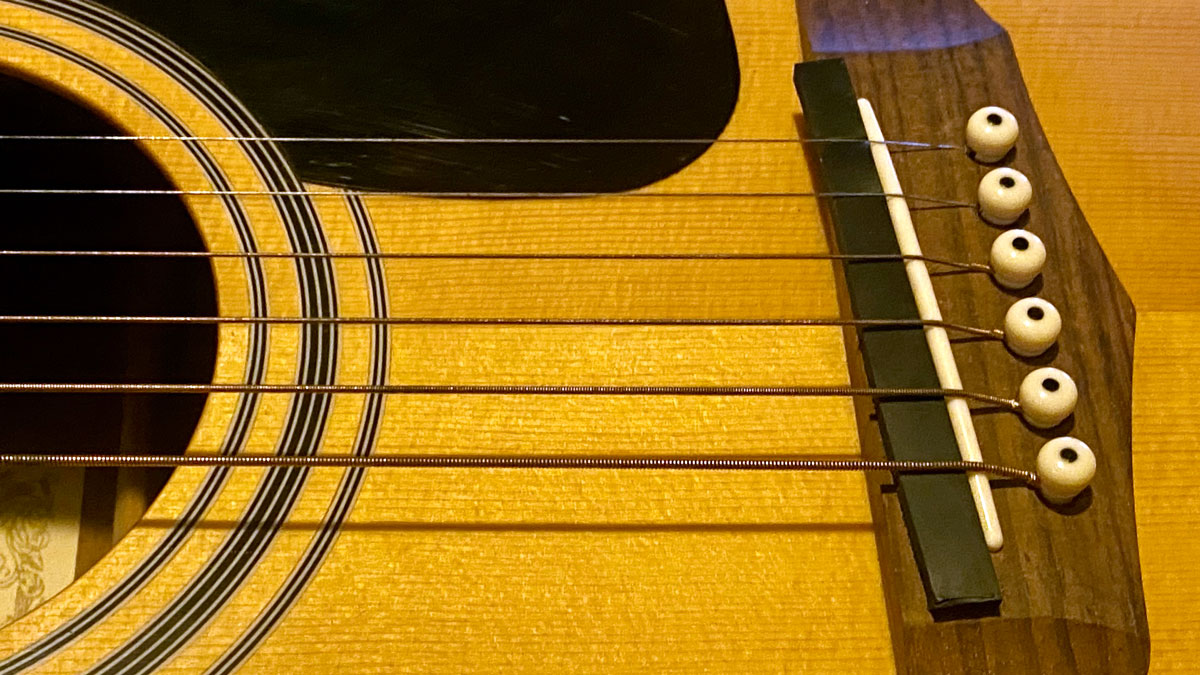How to get the most sought-after sound in indie rock without permanently modifying your guitar
A DIY rubber bridge project can help you get the distinctive tone beloved by the likes of Phoebe Bridgers, The National, Wilco, and many more

Rubber bridges are all the rage. By most accounts, the first rubber bridges began popping up in the early 2000s after Reuben Cox noticed a modified banjo with a wood and metal wedge beneath the strings. The result was a muted but clear sound.
It wasn’t long before Cox introduced this concept into his own guitar shop, creating a style of guitar that would eventually be adopted by artists including Bob Dylan, Wilco, and Phoebe Bridgers – check out our rundown of rubber bridge guitar songs for more songs recorded using the mod.
The sound reached its commercial zenith on Taylor Swift’s Folklore, which was produced by The National’s Aaron Dessner, and Cox’s instruments have even become the subject of a documentary film, Really Good Rejects.
What is a rubber bridge guitar?
Like the name suggests, a rubber bridge guitar utilizes a piece of rubber to muffle the guitar strings without completely suffocating them.
On most guitars, this modification requires replacing the standard bridge and saddle with a rubber system and a tailpiece. The result is a folk-style, banjo-like sound.
The cleanest DIY rubber bridge
One common problem that artists encounter while installing rubber bridges is reduced projection. Rubber bridges naturally create a muted sound. But, without the appropriate hardware, the sound can be difficult to project to audiences during performances.
One of the best ways to solve this issue is by installing a high-output pickup in either an acoustic or electric guitar in addition to the rubber bridge. The increased sensitivity of the pickup allows you to project the muted sound more effectively. The winning combination is typically a hot-output pickup with a piezo mic.
All the latest guitar news, interviews, lessons, reviews, deals and more, direct to your inbox!
In a 2022 interview with Guitar World, Cox acknowledged that artists have been attempting to produce the muted sound of a rubber bridge by other means for decades, but these other methods aren't as effective as the bridge itself.
“People have been dampening strings by various means [for years],” he said. “But the rubber bridge, as it exists now, I think is better because the mute is the bridge, so it integrates way better with everything else. If you put foam in front of the bridge, it makes everything intonate sharp, but string-to-string feel is very uniform [with a rubber bridge].”
Cox's rubber bridge system continues to appear in popular music today because it works.
Basic rubber bridge installation
If you’re not interested in purchasing a customized rubber bridge guitar, or you’d prefer to complete the modification yourself, you can typically purchase the basic components for about $50. But as a relatively obscure modification, it’s pretty difficult to find kits for this purpose.
The permanent modification for a rubber bridge guitar would involve ordering a customized rubber saddle or creating your own with a hardened piece of rubber. And you’ll need a tailpiece, as well.
Installation
Experimental DIY rubber bridges
If you only have one guitar or you don’t want to fully commit to permanent modifications, there are some minor changes you can make to achieve the muted rubber bridge sound.
One strategy that artists are using to create this sound is to replace the guitar’s existing saddle with one they’ve made out of hardened rubber before restringing their guitar like a standard acoustic.
The key to this approach is to create shallow slots for the strings to ensure that they still ring out. The problem with this strategy is that, if the rubber is too soft, the strings will likely cut through the rubber over time, which makes it a temporary solution. But switching to a set of light strings may help to reduce their impact on the rubber.
Some artists are also placing a thin layer of rubber on top of the existing saddle. This strategy will create the desired muted sound, but it will also give your guitar higher action. You could sand the bottom of the saddle down to address this issue. Over time, the rubber strip may need to be replaced, as well.
If your strings aren’t quite as muted as desired, cut deeper grooves into the rubber. The goal is to create a slightly dead sound in the strings.
Creating the rubber bridge sound with no modifications

Like Cox indicated, guitarists have been making minor modifications to their instruments for decades to achieve a muted sound. And you don’t necessarily have to make major adjustments to accomplish that goal.
Today, you can make or buy a mute pad from Etsy that exists for the same purpose. The perk of having this tool is that it can quickly be engaged or removed. But it may produce results with less clarity than a standard installation.
You could also thread a thin piece of rubber through your strings, or place a thick piece of rubber next to the saddle to get the same effect, as you can see above.
This is the quickest and easiest way to approximate the sound of Cox’s designs – and a great way to test the waters if you’re considering investing in the real deal further down the line.
Our own News Editor, Matt Owen, tried a rubber bridge model himself for a month, and had this to say.
“Do you need a dedicated rubber bridge guitar? It all depends on what sort of music you enjoy and play. If lo-fi pop is your thing, you’ll probably be impressed, but it is very much a one-trick-guitar, at least at first, so don’t expect it to behave like your current acoustic guitar – it won’t.
“Having said that, the rubber bridge guitar does seem to be a pretty invaluable tool for practicing, writing, and recording, if not performing. I’d like to think my early fingerstyle wobbles have merely helped refine my playing in this area, and have made me a more aware acoustic guitar player because of it.
“I have also experimented with new compositional ideas that I might not have stumbled on if playing a regular ‘ol acoustic.
“Likewise, while I wouldn’t necessarily gig with this, I would record with it. After all, its track record of fleshing out the frequency spectrum and adding a subtle ‘something else’ to a recording is well documented. It would sit very nicely underneath some double-tracked acoustics, as a subtle pad of sorts.
“There’s a reason why the likes of Taylor Swift, The National, and Phoebe Bridgers all swear by the rubber bridge guitar. It’s a fine instrument with a unique sound that’s certainly worth experimenting with if you get a chance.”
You must confirm your public display name before commenting
Please logout and then login again, you will then be prompted to enter your display name.


